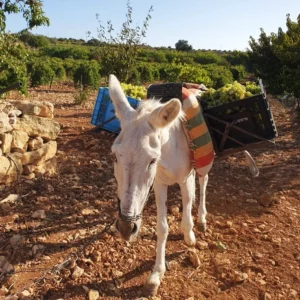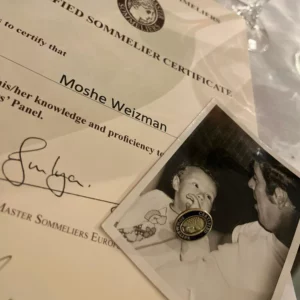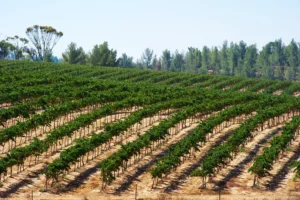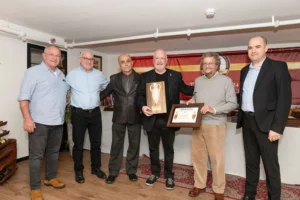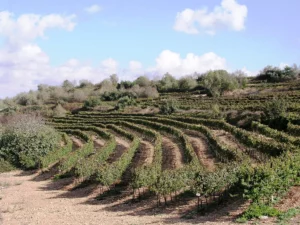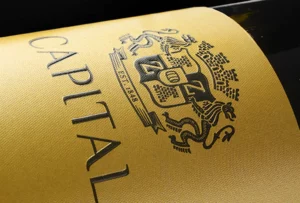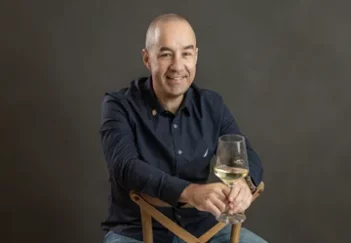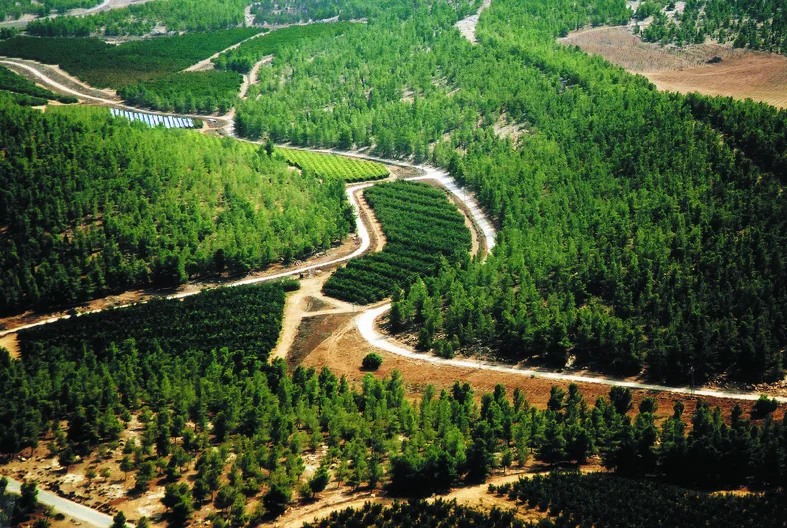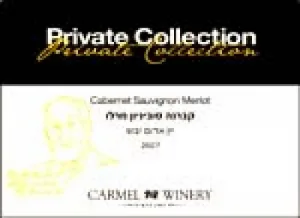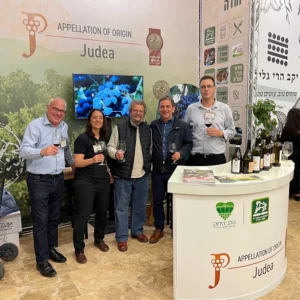Israel has a festival for planting trees, which is called Tu Bishvat. It is celebrated literally by planting trees and has also become a festival with ecological undertones, reminding us to care for the environment. School children will go on tree planting activities and people from abroad are encouraged to make a donation for a tree to be planted in their name. This respect for trees and the environment has stood Israel well. It is the only country in the world with more trees than one hundred years ago.
An example of trees in the wine context is Yatir Forest. This is the meeting place between the Hebron Hills, the Negev Desert and the Judean Desert. Israel?s first Prime Minister, David Ben Gurion, wanted to stop the advance of the desert and make the desert bloom. It was his idea to plant the forest. The experts told him in no uncertain terms, that it would not work. The trees would not survive. So, Ben Gurion impatiently said: ?Change the experts!? The forest was planted beginning in 1964. It is today Israel?s largest planted forest.
Nestling in the forest, at elevations of between 600 and 900 meters above sea level, are the prized vineyards of Yatir Winery, which is in itself situated at Tel Arad in the northeastern Negev. Vineyards for wine grapes were first planted there in 1996/7. Yatir Winery was founded in 2000, and their first wines were launched in 2004. This semi-arid, forest area has proved to be a unique terroir. The rest is history. In 2007, the Yatir Forest 2003, the prestige wine of the winery, became the first Israeli, kosher or Eastern Mediterranean wine to score 93 points in the Robert Parker?s Wine Advocate.
Amongst the trees and vineyards of Yatir Forest, there are over eighty old wine presses and numerous dark and cool caves, which would have been used to store amphorae full of maturing wine in those days. When the future King David was hiding from the anger of King Saul, it is thought he hid in caves such as these. Thus in the Israel of today, the ancient and modern coexist together, giving a flavor of why this is such a fascinating wine country.
The Greek historian Thucydides wrote that man became civilized when he planted the vine and olive tree. There are areas of Israel, where the planting of vineyards staked out the land. The most obvious example is from 1882, when Baron Edmond de Rothschild invested in founding a modern Israel wine industry. He sponsored farmers of the First Aliyah, to plant vineyards in the valleys surrounding the southern slopes of Mount Carmel and in the central coastal plain, south east of Jaffa, and what is now Tel Aviv. There were many crops that were planted. They experimented with every kind of fruit tree and crop, but it was the planting of vineyards that succeeded in the Eastern Mediterannean, Levantine climate. The vineyards became the symbol of the resettlement of Israel, and the Jaffa orange became the fruit of the young country.
In 1976 the first vineyards were planted on the Golan Heights. This volcanic, high elevation plateau came to Israel as a result of the Six Day War. It was not to be long before wine and vineyards became the most visual and successful product of the Golan. Maybe the success of award winning wines and the pastoral view of vineyards, hastened its acceptance as being considered part of Israel.
Since the turn of the millennium, the Central Mountain wine route, in Judea and Samaria, has become established. It is relatively new as a vineyard region. The Carmel Har Bracha Merlot 2002 was the first wine that gave notice of this new wine region. It was a single vineyard wine grown on the same mountains where wine was made in Biblical times. Its success encouraged others and there are now a string of vineyards and wineries, where twenty years ago, there was none. Again wine has played its part in settlement of the land. No doubt from a public relations point of view, talk of wine, vineyards and tourism, is certainly more sympathetically received than the controversial aspects of West Bank politics.
Furthermore, making the desert bloom according the vision of Ben Gurion has actually come true. Nothing so symbolizes this as seeing the green river of vineyards snaking through the Nahal Zin region of Mitzpe Ramon at 800 meters elevation. The vineyards form a winding, green line, standing out from surrounding brown, yellow and beige tints of the harsh desert. It is striking and moving to see it. However as is true everywhere in Israel, modern vineyards only repeat the wine growers of the past, in this case, the Nabateans, who had an incredibly advanced wine trade in the desert.
There was a time Israel was way behind the rest of the world in terms of the environment. The Golan Heights Winery was the first to produce an organically grown wine from the 2002 vintage. The Yarden Odem Vineyard Chardonnay won international awards at the very highest level. Bashan Winery was the first totally organic winery but did not stand the test of time. These days Lotem and Harashim are organic wineries and the Zivon vineyard, near Mount Meron in the Upper Galilee, is on the way to becoming biodynamic.
In the last ten years, wineries have become more ecologically active. Tabor Winery has created ecological vineyards by fulfilling the guidelines laid down by the Society of the Preservation of Nature, over a three year period. This fits in to a range of environmental friendly standards in the vineyard, which are good for the health of the surroundings, the quality of the vines and also the soul of the practitioners.?
They allowed a cover crop to grow, planted trees within the boundaries of the vineyard, created nesting areas for birds, and placed piles of stones and boulders to encourage the return of wild life. The flora and fauna created its own ecosystem and a new order of things in which the natural balance of nature is respected and encouraged. Tabor Winery even changed the winery logo to that of a barn owl, one of the species to benefit from their activities.
The Golan Heights Winery were the first Israeli winery to be certified sustainable internationally and they have chosen leaders of the field to collaborate with, in this instance Lodi Rules. Lodi Rules is California?s original sustainable viticulture program. It began ground up in 2005 with growers seeking to define new standards for their region. Lodi Rules promotes the adoption of over 120 sustainability standards which relate to soil management, ecosystem management, water management, pest management, business management and human resources. Whereas certified organic and biodynamic farming relate to the environment, certified sustainable farming is all encompassing and relates to the environment, the people and the business.? Each of the standards is measurable and auditable. The certification process is rigorous and is audited by third parties. The result of this cooperation was that in 2017, the Golan Heights Winery and sister company, Galil Mountain Winery, became the first international wineries from anywhere, to be certified as sustainable according to the Lodi Rules.
Tzora Vineyards, one of our leading small wineries, also received an international certification for sustainable viticulture. This time from Fair?n Green. This is a European body, based in Germany. It is also a system for sustainable viticulture and also covers areas of management, environment, protection and social responsibility. These three wineries, Tabor, Golan Heights and Tzora, are setting a commendable example to other Israeli wineries.
The Tu Bishvat festival may be celebrated with a Seder Meal, rather like the more well-known Seder Night at Passover. On one level, it is a party to celebrate nature for children. On another it may be interpreted through Kabbalah to represent different states of existence, rebirth, creation and wholeness, and celebrated on altogether another level. Like at Passover, four glasses of wine are required, but in this instance, it is to celebrate the four seasons. The first glass is a white wine to represent the bleak, dormant time of winter. The second is white wine with a splash of red in it, which represents the awakening of spring. The third is a red wine with a splash of white in it, to represent the blossoming and flowering. The fourth is a red wine to illustrate the fullness, ripeness and harvest of the late summer, early autumn.
These glasses of wine are accompanied by fruits of the Land of Israel. With the first glass, a fruit is served that is hard on the outside and soft on the inside. Examples include walnuts or almonds. The next category of fruit with the second glass is soft with a pip in the center, like olives or dates. The third category of fruit is soft throughout and totally edible, such as figs, grapes or raisins. The fourth category of fruit has a tough skin but sweet fruit inside, such as mangos, avocados or sabras. Each grouping has its own symbolic value and meaning.
As Tu Bishvat, is primarily an educational process for children, you may choose to use grape juice. A red and white grape juice, such as the Carmel Tirosh, is all you need. The second and third glasses are made by simply making a blend of the red and white accordingly; approximately 2/3rds white and 1/3rd red for the second glass and the opposite measurements for the third glass.
Another alternative is to purchase low alcohol, slightly sparkling Moscato style wines, which are suitable for families. The Carmel Buzz Moscato and Carignano are one option, and Zion and Teperberg Wineries both have Red and White Moscatos. The Red Moscatos are made from Muscat Hamburg grapes and the white from Muscat of Alexandria.
For those wanting to use table wines, similarly a red and white wine is all that is required. You just have to do some blending. However the wine maven may prefer to buy a white wine, a pale pink rose, either a deep colored rose or a light red wine, and a red wine to represent the four wines.
At Tu Bishvat we should appreciate the world around us. This is particularly poignant in the year of a pandemic which has destroyed the order of life as we know it. However in the vineyard and in nature, life continues as before, and with less pollution than in a regular year. In Israel, at this festival, we focus on nature. It makes us feel fortunate to see all the trees, vineyards and olive groves around us.
Adam Montefiore is a wine trade veteran who has advanced Israeli wine for 35 years. He is the wine writer for the Jerusalem Post. www.adammontefiore.com



